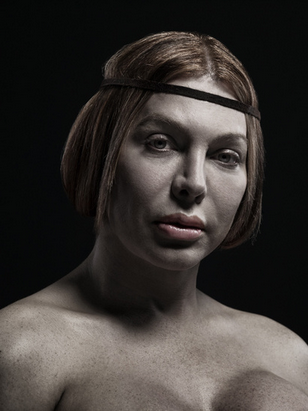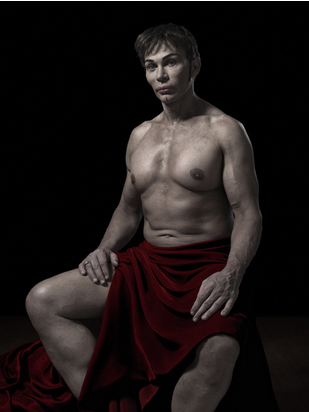
I went to an art gallery and saw a photography exhibit that was so powerful I have not been able to stop thinking about it. The show is called "A New Kind of Beauty" and the artist is Phil Toledano. These are portraits of men and women who have had multiple plastic surgery procedures. Some are transgender. All are obviously "surgical" looking. In many cases it is impossible to decipher the subject's gender. In many ways they look the same.
Toledano suggests in the introduction to the show catalogue that we are at a turning point in history because of plastic surgeons' ability to transform appearances in an unprecedented way. He suggests that plastic surgeons' hands may now be creating a new kind of beauty. But are these people even beautiful? Ruminating over these photos has been fascinating, and they are a wonderful departing point for all those who are interested in beauty.
I am critical of the media for its disproportional portrayal of patients with overdone results, though the reason is clear: it is only interesting to feature patients with shocking results. The "normal" patients have results that do not give clues as to their surgery. At first glance these photos seem to be another exploitation of plastic surgery. Any such condemnation would be incorrect because the impact of the show is so strong and thought provoking.


There is absolute perfection in the lighting, composition, and printing. They look like 17th century court paintings by a Dutch master rather than contemporary photographs. The sitters are positioned in classic poses, draped in robes or sheets. They are contrasted against black backgrounds, akin to a Holbein portrait. The harsh shadows in their faces are Rembrandtesque. The skin tones are so desaturated that they no longer look lifelike, but rather something in between an old painting and the sallow complexion of an "undead" vampire. The boldest colors are the simulated rays of light highlighting the hair a la Vermeer.
Toledano treats his subjects with great respect. Yet they are obviously odd-looking and we sense they have had tragic lives. We are being treated to an Arbus-like voyeuristic glance into societal outcasts. They exude complicated and confused emotions. Are they proud of their looks? Or are they a bit ashamed and concerned with how they will be viewed? No two visitors to the show might ever agree.
It is clear to me that these photos do not demonstrate a "new beauty" as the show title suggests, but rather an unwavering attempt to create historic standards of beauty in those who do not have that potential. With the limits of cosmetic surgery, those goals are missed or overshot. Angelina Jolie's lips are as yet inimitable, and trying to replicate them often results in horridly malformed lips that are not beautiful by any definition.
Plastic surgeons will never want to create a new beauty. Hair style, lipstick tones, and even desired amount of cleavage changes, but the fundamental canons of human beauty are immutable. What man today would not want the body of a 2,000-year-old Greek statue? The spiral of a Nautilus shell, the dimensions of the Parthenon, and the landmark features of the human face all follow the Golden Ratio. We do not understand why this simple proportion strikes us as perfect, but it does and probably always will.
Notwithstanding that, even mainstream plastic surgery regularly creates tragic plastic surgery results. Walk down Rodeo Drive or peruse People Magazine and you will see minions of housewives and actresses who look like shocked catfish in wind tunnels, and a bevy of young women apparently hiding Zeppelins in their brassieres. Like the men and women of Toledano's show, they are a failed attempt at achieving classic beauty and youth.
Full lips are characteristic of hormone-rich fertile women and full breasts are a sign of youth. It is appropriate to modestly improve or restore these features. But plastic surgeons and their patients too frequently lose perspective about what they are doing. The result is women who look like caricatures of the ideal beautiful.
Every day I am approached by patients asking for more plastic surgery who have already had too much. While it is an individual's right to choose how they want to look, so too is it the plastic surgeons' responsibility to not be a part of a process that creates a look they believe is undesirable.
"A New Kind of Beauty" made me take a step back to consider what I do. Am I inadvertently creating bizarre results? I really do not think so, but it is a question that I must regularly ask myself. No surgeon will admit they are creating the women with the surgically distorted bodies that invite snickering and pejorative comments; but obviously many plastic surgeons are. Unfortunately, surgeon avarice and even bad taste preempts meaningful introspection. And the companies that make injectable fillers refer to the women getting their products not as patients or customers, but as "users." Users? What an appropriate euphemism. It is hard to break a habit when the supplier and the pusher have the same goal.
All plastic surgeons need to see this show. If you have a loved one who has had too much surgery, take them and talk about it.
Hopefully one day Mayor Bloomberg will limit each woman to 16 syringes of filler per year.
A New Kind of Beauty is now showing at Paul Kopeikin Gallery in Los Angeles.
Read more on Dr. Steven Teitelbaum's blog: www.drteitelbaum.com
